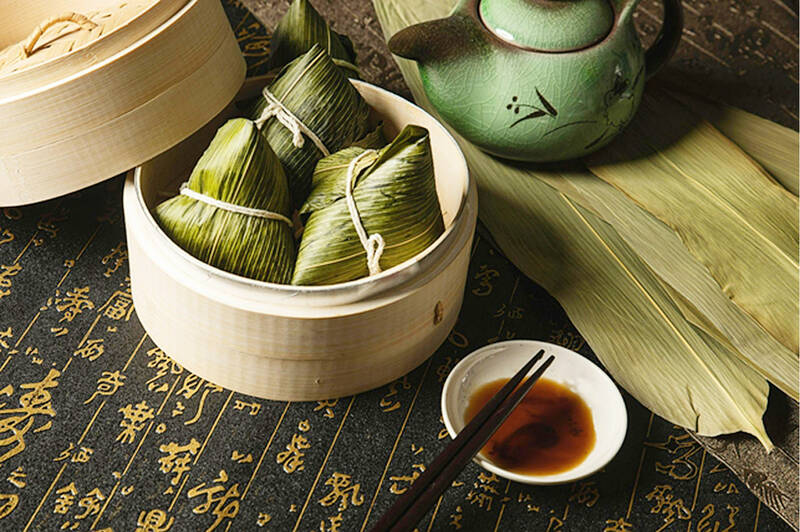Around the time of the Dragon Boat Festival in June, the streets of Taiwan are filled with the delightful aroma of zongzi, a traditional snack made of sticky rice wrapped in leaves. The leaves are folded into a cone and then filled with sticky rice and other ingredients such as braised pork belly, peanuts and salted duck egg yolks. The filled leaves are then tightly tied with kitchen twine and ready for cooking.
每到六月端午時節,街頭巷尾就會飄出粽子的香氣。粽子是將糯米包進粽葉的傳統美食,先將粽葉折成圓錐狀塞入糯米,以及紅燒肉、花生、鹹鴨蛋黃等配料,用棉線綁緊後即可烹煮。
Dragon Boat Festival (n. phr.) 端午節

Photo: Pexels l 圖片:Pexels
aroma (n.) 香氣,香味
As a zongzi is cooked, the leaves release an herbal aroma that is a feature of this beloved dish. The cooking method of zongzi can differ greatly between regions. People in northern Taiwan usually steam zongzi, in which its rice and ingredients are stir-fried before being steamed, resulting in a more flavorful taste. People in southern Taiwan prefer to boil them. The boiled version has a gooey and sticky texture and a stronger herbal aroma due to the longer boiling time.
粽煮過之後粽葉會發出香氣,是粽子的一大特色。台灣南北煮粽子的方式不同,北部人大多用蒸的,米飯和配料蒸之前會先炒出香氣,南部人則偏好用水煮的粽子,煮的時間久,米粒更軟黏,粽葉香氣更濃。
herbal (adj.) 藥草的,香草的
gooey (adj.) 軟黏的
In addition to regional variations in the cooking methods used for zongzi, the leaves used to wrap them also vary by region. Three commonly used materials to wrap zongzi are giant timber bamboo leaves, the husks of makinoi bamboo and shell ginger leaves. In the south, where zongzi are usually boiled, the giant timber bamboo leaves they are wrapped in help them withstand the boiling process. In the north, husks of makinoi bamboo are more often used as a wrapper, which has a distinctive light brown color as they are the outer shell of bamboo.
除了烹煮方式,粽葉也是因地而異。台灣常用的粽葉有麻竹葉、桂竹葉和月桃葉,麻竹葉適合需長時間水煮的南部粽,桂竹葉則常用來包北部粽。桂竹葉是竹籜(筍殼),故為淺棕色。
Shell ginger can be seen everywhere in the countryside of Taiwan. The Hakka people, in particular, appreciate and use its leaves as a wrapper for zongzi because it imparts an aroma that comes from the plant to the rice. Its leaves can not only be used as a zongzi wrapper, the Paiwan people, a group of indigenous people in Taiwan, have traditionally used them for weaving handicrafts like baskets.
月桃於台灣田野間隨處可見。客家人特別愛用月桃葉包粽子,會讓粽子帶有月桃香氣。月桃葉不止能作粽葉,用途廣泛,排灣族的傳統編織也會用月桃葉編成籃子等手工藝品。
countryside (n,) 鄉村,農村地區
Hakka (n.) 強迫(某人)客家人
indigenous people (n. phr.) 原住民
The tradition of eating zongzi during Dragon Boat Festival can be dated back to the Warring States period (c. 475–221 BCE). It is celebrated on the fifth day of the fifth lunar month to commemorate Qu Yuan (c. 340–278 BCE), a renowned poet and loyal statesman of the Chu state. His honesty and outspoken nature often put him at odds with the ruler of Chu, so he was banished from the state for 18 years. During his banishment, Qu Yuan remained devoted to his state, but watched with despair as it continued to decline.
端午節吃粽子的習俗歷史悠久,最早可追溯至戰國時期(約公元前475–221年)。每年農曆五月五日的端午節,是為了紀念楚國愛國詩人屈原(約公元前340–278 年),他因直言不諱得罪楚王,遭流放18 年。即便流落他鄉,仍心繫故國,卻只能眼睜睜看著楚國走向衰亡。
statesman (n.)(受人尊敬的)政治家
banish (v.) 放逐,驅除出境
Qu Yuan was overwhelmed with grief and drowned himself in the Miluo River on the day that is now commemorated as the Dragon Boat Festival. To honor his integrity, people wanted to keep the fish in the river away from his body. They rowed boats to scare away fish and threw rice wrapped in leaves into the river for them to eat instead of his body. Over time, this memorial has evolved into the popular celebration of the Dragon Boat Festival, which includes zongzi eating and dragon boat racing and has been observed for centuries.
他悲痛至極,於農曆五月初五投汨羅江自盡。人們感念他的情操,於是在河中划船驅趕魚群,並用竹葉包米飯扔進河裡,希望河中的魚不要去吃屈原的身體。千年之後,這項紀念活動已轉變成端午節吃粽子和賽龍舟的習俗。
drown (v.) 淹死,溺死
observe (v.) 過,慶祝,紀念(節日、事件)
文章由書林出版公司提供:
www.bookman.com.tw

In the digital age, where communication revolves around text messages, “telephone phobia” (also known as “telephobia”) has become increasingly common, especially among young adults. Despite the ubiquity of smartphones, a significant number of individuals experience anxiety when __1__ making or receiving a phone call. Telephobia, in essence, is a fear or reluctance related to speaking on the phone. __2__ other communication methods, phone conversations require spontaneous responses and lack visual feedback such as body language and facial expressions. In such a real-time situation, telephobia sufferers are concerned about their inability to respond or express themselves appropriately, which can lead

A: Apart from singer Daniel Kang, more South Korean stars are coming to Taiwan in March. B: Really? Like who? A: Taeyeon of Girls’ Generation will hold a concert at the Taipei Dome on March 16. B: So she’ll set a milestone by becoming the first K-pop artist to stage a show at the venue. A: Singer Lee Mu-jin, boy group NCT 127 and girl group GFRIEND are also visiting Taiwan. I can’t wait. A: 除了姜丹尼爾,3月有不少韓星訪台。 B: 真的嗎?有誰啊? A: 像是少女時代的太妍,3月16日即將唱進大巨蛋。 B: 成為首位破蛋的韓流歌手,這可真是一項里程碑! A: 歌手李茂珍、男團NCT 127、女團GFRIEND 3月也要來,真是令人期待。 (By Eddy Chang, Taipei Times/台北時報張迪)

>> Bilingual Story is a fictionalized account 雙語故事部分內容純屬虛構

本文由生成式 AI 協作,本刊編輯編修 Striking a balance between taste and health can be difficult, especially for those who appreciate Asian food. Many Asian dishes are high in sodium, which can be harmful to health, including increasing the risk of hypertension and stroke. In Japan, this problem is especially severe, with the average adult __1__ about 10 grams of salt per day, double the amount recommended by the World Health Organization. While many people seek healthier choices, __2__ salt can often leave food tasting bland, which makes low-sodium diets difficult to maintain. A Japanese compa ny has developed a __3__ utensil that makes